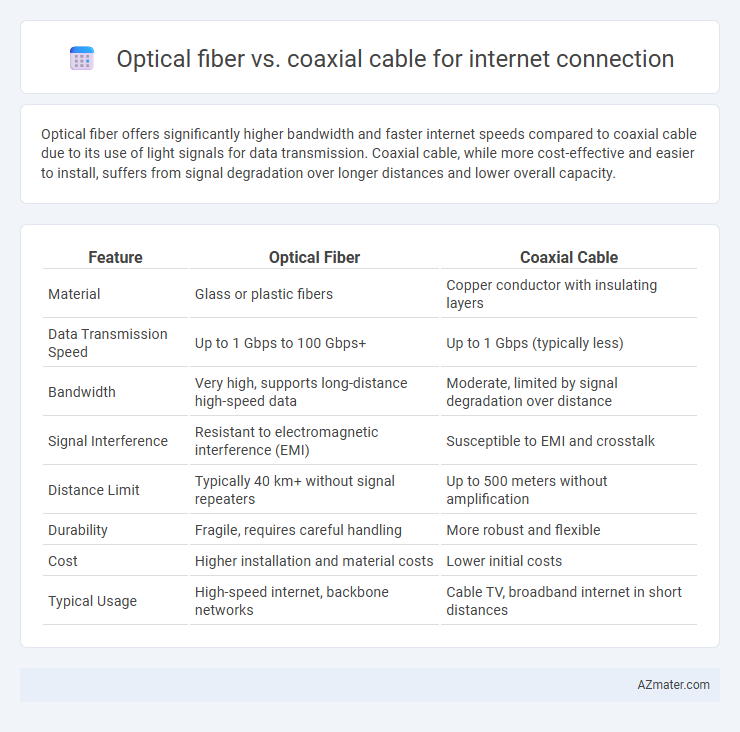Optical fiber offers significantly higher bandwidth and faster internet speeds compared to coaxial cable due to its use of light signals for data transmission. Coaxial cable, while more cost-effective and easier to install, suffers from signal degradation over longer distances and lower overall capacity.
Table of Comparison
| Feature | Optical Fiber | Coaxial Cable |
|---|---|---|
| Material | Glass or plastic fibers | Copper conductor with insulating layers |
| Data Transmission Speed | Up to 1 Gbps to 100 Gbps+ | Up to 1 Gbps (typically less) |
| Bandwidth | Very high, supports long-distance high-speed data | Moderate, limited by signal degradation over distance |
| Signal Interference | Resistant to electromagnetic interference (EMI) | Susceptible to EMI and crosstalk |
| Distance Limit | Typically 40 km+ without signal repeaters | Up to 500 meters without amplification |
| Durability | Fragile, requires careful handling | More robust and flexible |
| Cost | Higher installation and material costs | Lower initial costs |
| Typical Usage | High-speed internet, backbone networks | Cable TV, broadband internet in short distances |
Introduction to Internet Transmission Technologies
Optical fiber offers significantly higher bandwidth and faster data transmission speeds compared to coaxial cable, making it ideal for modern internet applications requiring large data transfers and low latency. Coaxial cable remains widely used due to its lower cost and ease of installation, supporting broadband internet with decent speed suitable for residential use. Internet transmission technology increasingly favors optical fiber for future-proof infrastructure, enabling superior scalability and reduced signal degradation over long distances.
Overview of Optical Fiber and Coaxial Cable
Optical fiber uses thin strands of glass or plastic to transmit data as light signals, offering higher bandwidth and faster internet speeds compared to coaxial cable. Coaxial cable consists of a copper core, insulating layer, and metallic shield, enabling reliable data transmission over moderate distances with lower latency. Optical fiber is ideal for long-distance, high-speed internet connections, while coaxial cable remains common in residential broadband setups due to its cost-effectiveness and established infrastructure.
Speed Comparison: Optical Fiber vs Coaxial Cable
Optical fiber offers significantly higher internet speeds compared to coaxial cable, with fiber connections supporting up to 1 Gbps and beyond, while coaxial cable typically maxes out around 300 Mbps in most residential setups. The fiber's ability to transmit data using light signals allows for minimal signal loss and interference, resulting in faster and more reliable internet performance. Coaxial cables rely on electrical signals and are prone to degradation over distance, limiting their speed potential compared to the advanced technology of optical fiber.
Bandwidth Capabilities and Data Transmission
Optical fiber offers significantly higher bandwidth capabilities than coaxial cable, supporting data transmission speeds up to several terabits per second, ideal for high-demand internet applications. Coaxial cable, while more affordable and easier to install, typically provides bandwidths up to a few gigabits per second, suitable for standard broadband services. Optical fiber's low signal attenuation and resistance to electromagnetic interference result in more reliable and faster long-distance data transmission.
Reliability and Signal Interference
Optical fiber offers superior reliability compared to coaxial cable due to its immunity to electromagnetic interference (EMI) and radio frequency interference (RFI), ensuring consistent signal quality over long distances. Coaxial cables, while robust, are susceptible to signal degradation from external interference sources, impacting internet connection stability and speed. Fiber optic infrastructure supports higher bandwidth and lower latency, making it the preferred choice for reliable, high-performance internet connectivity in both residential and commercial applications.
Installation and Maintenance Requirements
Optical fiber installation demands specialized equipment and skilled technicians to precisely handle delicate glass fibers, resulting in higher initial setup costs compared to coaxial cables. Coaxial cable installation is more straightforward, using standard connectors and established techniques, which reduces labor time and expenses. Maintenance for optical fiber involves careful monitoring for signal degradation and fiber breaks, whereas coaxial cables are more susceptible to interference and physical damage, requiring periodic shielding repairs.
Cost Differences: Initial and Long-Term
Optical fiber offers higher initial installation costs compared to coaxial cable due to advanced technology and material expenses, but it provides significantly lower maintenance and upgrade costs over time. Coaxial cable is generally less expensive to install initially, making it suitable for budget-conscious setups, yet it requires more frequent repairs and has limited bandwidth scalability, leading to higher long-term expenses. The total cost of ownership for optical fiber becomes more economical in the long run, especially for high-speed internet requirements and expanding network demands.
Availability and Accessibility for Consumers
Optical fiber offers superior bandwidth but its availability is often limited to urban and suburban areas due to high infrastructure costs, making it less accessible in rural regions. Coaxial cable networks are more widely established, providing broader consumer access, especially in older neighborhoods and areas with existing cable TV infrastructure. Consumers in remote locations typically find coaxial connections more accessible, while fiber deployment efforts continue to expand to improve availability.
Future-Proofing and Scalability
Optical fiber offers superior future-proofing due to its significantly higher bandwidth capacity and ability to support ultra-fast internet speeds beyond 100 Gbps, making it ideal for evolving digital demands. Coaxial cable, while initially more affordable, faces limitations in scalability and signal degradation over long distances, restricting its effectiveness as data consumption grows. Investing in optical fiber ensures a scalable infrastructure capable of accommodating advanced technologies like 5G, IoT, and cloud-based services without frequent upgrades.
Which is Better for Your Internet Needs?
Optical fiber offers significantly higher bandwidth and faster internet speeds compared to coaxial cable, making it ideal for heavy streaming, gaming, and large data transfers. Coaxial cable is more widespread and generally less expensive, providing adequate performance for everyday browsing and standard HD streaming. For future-proofing your internet needs and achieving the best long-term performance, optical fiber is the better choice despite higher initial installation costs.

Infographic: Optical fiber vs Coaxial cable for Internet connection
 azmater.com
azmater.com